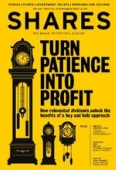Archived article
Please note that tax, investment, pension and ISA rules can change and the information and any views contained in this article may now be inaccurate.
Why we think National Grid is a firm buy for the future

The UK stock market has been beset with uncertainties all year with Brexit negotiations dragging on, the pound plunging and UK domestic growth stuck in a rut.
This could all change in 2019 but in the meantime there is one very compelling reason to own shares in National Grid (NG.) – inflation-protected dividends.
RPI inflation (retail price index) in September came in at 3.3%, according to figures from the Office of National Statistics (ONS) and forecasts suggest that figure to settle at around 3% out to 2023.
As the cost of living in Britain rises it makes income benchmarked to inflation or better increasingly attractive. National Grid, Britain’s largest utility supplier, renewed its commitment to grow its dividend to match RPI inflation or better ‘for the foreseeable future’ earlier this year.
This is important for investors who rely on growing income to help pay their monthly bills but it also should act as a magnet for anyone looking to benefit from the powerful effect of compounding over time.
As fund manager Mark Barnett said recently, around 60% of the total return (share price gains and dividends combined) earned by the Perpetual Income & Growth Trust (PLI) that he runs came from reinvesting dividends.
INFRASTRUCTURE FOCUS
National Grid runs much of the UK’s electricity and gas supply infrastructure, with similarly regulated operations in the US. It has a long track record of steadily increasing its annual payout to shareholders dating beyond the 2002 merger with Lattice, which formed an electricity and gas transmission national champion.
It has missed its dividend growth target just once in the past 10 years (2012), when RPI was coming down from a spell running at 5%-plus. This year’s full year forecast payout of 47.45p implies a 5.5% income yield.
This sort of inflation-beating track record is matched by other utility stocks (electricity, gas, water suppliers, for example) but National Grid is the UK operator least threatened by tariff price caps being introduced across the industry.
This is not to say that the group is immune from its own challenges, not least a hawkish regulatory environment both sides of the Atlantic, strike action and one-off costs as it looks to realign its operating expenses for the future.
But we believe National Grid is pulling the right levers as it balances the demands of shareholders, workers, regulators and customers. A scheme to cut staff numbers through a programme of voluntary redundancies announced alongside recent half year results is a good example, even if that will mean some short-term one-off costs. (SF)
Important information:
These articles are provided by Shares magazine which is published by AJ Bell Media, a part of AJ Bell. Shares is not written by AJ Bell.
Shares is provided for your general information and use and is not a personal recommendation to invest. It is not intended to be relied upon by you in making or not making any investment decisions. The investments referred to in these articles will not be suitable for all investors. If in doubt please seek appropriate independent financial advice.
Investors acting on the information in these articles do so at their own risk and AJ Bell Media and its staff do not accept liability for losses suffered by investors as a result of their investment decisions.
 magazine
magazine









